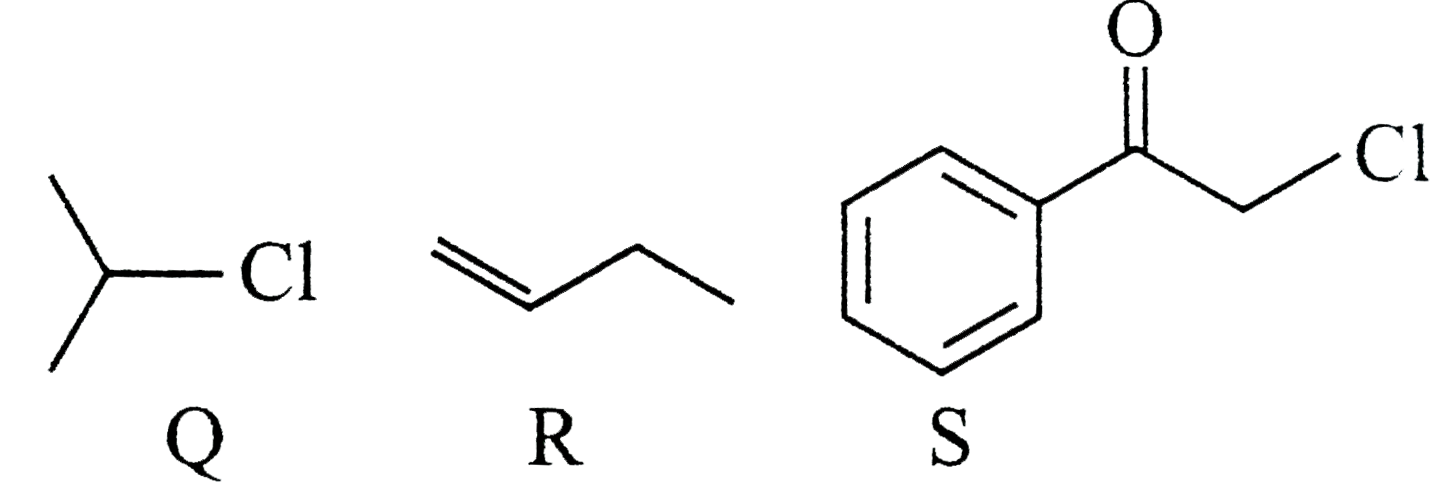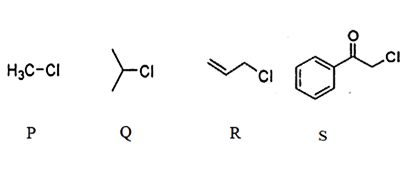KI in acetone, undergoes SN2 reaction with each of P,Q,R and S. The rate of the reaction vary as

A
PgtQgtRgtS
B
SgtPgtRgtQ
C
PgtRgtQgtS
D
RgtPgtSgtQ
Video Solution
Text Solution
The correct Answer is:B
Due to -R-effect of PhCO-group and -I-effect of Cl atom, the transition state is highly stabilized and hence compound (S) has the highest reactivity. Amongst P,Q,R,, P has the least steric hindrance, followed by R while Q has the highest steric hindrance. thus, reactivity decreases in the order: SgtPgtRgtQ, i.e., option (b) is correct.
|
Topper's Solved these Questions
- HALOALKANES AND HALOARENESBook:PRADEEPChapter:HALOALKANES AND HALOARENESExercise:Competition Focus (JEE (MAIN AND ADVANCED)/MEDICAL ENTRANCE SPECIAL (MULTIPLE CHOICE QUESTIONS-II))
Explore 8 Videos
- HALOALKANES AND HALOARENESBook:PRADEEPChapter:HALOALKANES AND HALOARENESExercise:Competition Focus (JEE (MAIN AND ADVANCED)/MEDICAL ENTRANCE SPECIAL (MULTIPLE CHOICE QUESTIONS-III COMPREHENSION TYPE ))
Explore 7 Videos
- HALOALKANES AND HALOARENESBook:PRADEEPChapter:HALOALKANES AND HALOARENESExercise:VALUE BASED QUESTIONS WITH ANSWERS
Explore 4 Videos
- GENERAL PRINCIPLES AND PROCESSES OF ISOLATION OF ELEMENTS Book:PRADEEPChapter:GENERAL PRINCIPLES AND PROCESSES OF ISOLATION OF ELEMENTS Exercise:Curiosity Questions
Explore 2 Videos
- ORGANIC COMPOUNDS CONTAINING NITROGENBook:PRADEEPChapter:ORGANIC COMPOUNDS CONTAINING NITROGENExercise:IMPORTANT QUESTIONS FOR BOARD EXAMINATION
Explore 27 Videos
Similar Questions
Knowledge Check
KI in acetone, undergoes SN2 reaction with each of P,Q,R and S The rates of the reaction very as
H3C−ClP .AP>Q>R>SBS>P>R>QCP>R>Q>SDR>P>S>Q
.AP>Q>R>SBS>P>R>QCP>R>Q>SDR>P>S>QKI dissolved in acetone undergoes SN2 reaction with each of P,Q,R and S. the reaction rates vary as:
 .AP>Q>R>SBS>P>R>QCP>R>Q>SDR>P>S>Q
.AP>Q>R>SBS>P>R>QCP>R>Q>SDR>P>S>QSN2 reaction are
Astereoselective as well as atereopecificBstereoselective but not stereospecificCstereospecific but not stereoselectiveDNeither stereospecific nor stereoselective





